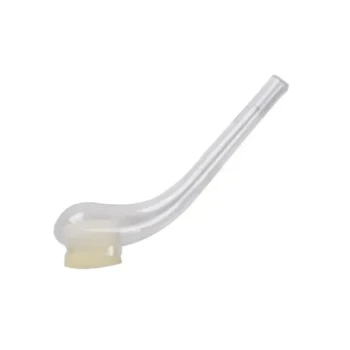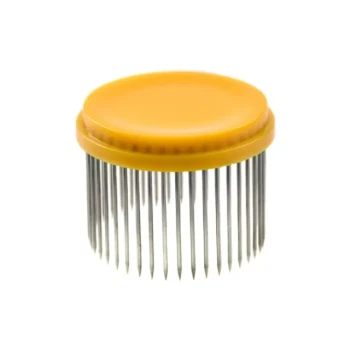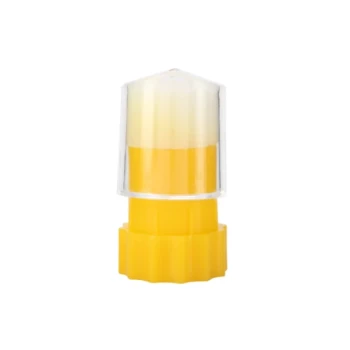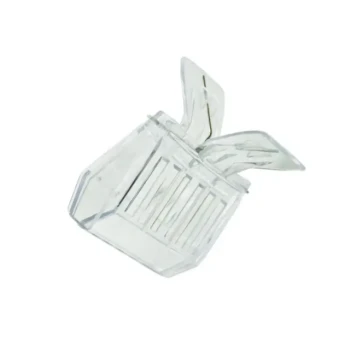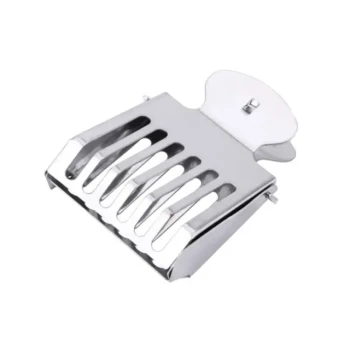At its core, a queen cup is a foundational structure built by worker bees as a potential cradle for a new queen. It's a small, wax cell that resembles an upside-down teacup and serves as a placeholder. Think of it as the bees building a nursery before they know if they will need it.
Seeing queen cups is not an immediate cause for alarm; it's a sign of a colony's preparedness. The critical distinction for a beekeeper is whether the cup is empty or contains an egg or larva, as this indicates the colony's active intent to raise a new queen.
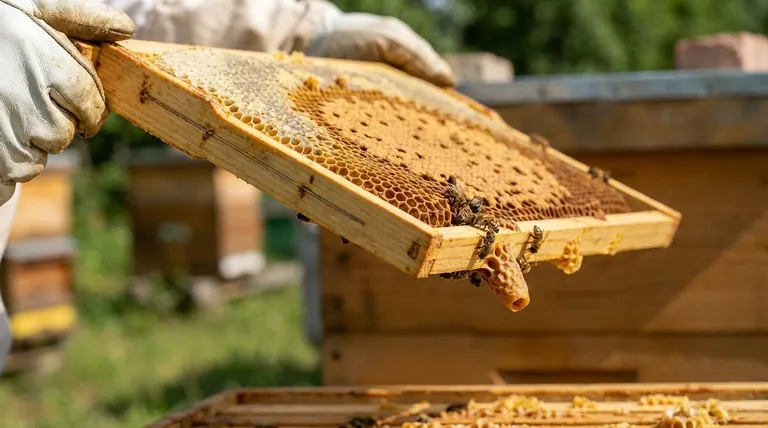
The Purpose and Appearance of a Queen Cup
A Proactive Measure
Worker bees often build empty queen cups as a matter of course. It's a proactive behavior that keeps the colony prepared for any eventuality that might require a new queen.
Their presence alone is simply a sign of a healthy, functioning colony that is planning for its future.
Distinctive Shape and Location
A queen cup is easily identified by its unique shape and orientation. Unlike the hexagonal cells used for workers or drones, it is round, deep, and points downwards.
You will typically find them along the bottom edge of a frame or in other open spaces within the hive where there is room for the cell to be extended.
The Critical Transition: From Cup to Cell
The moment a queen cup becomes significant is when the queen lays an egg inside it. Once the egg is laid and worker bees begin adding royal jelly, the structure is no longer just a cup.
It is now officially a queen cell, and the colony has committed to raising a new queen. The bees will extend the wax downwards, eventually sealing it into a structure that resembles a peanut shell.
What Queen Cups Signal About Your Hive
The number and location of occupied queen cells can tell you a great deal about the colony's intentions.
Supersedure Cells: Replacing a Failing Queen
If you find only a few queen cells, often located on the face of the comb rather than the bottom, it's likely a supersedure event.
This means the bees have detected that their current queen is failing—perhaps due to age, injury, or poor pheromone production—and are proactively raising her replacement. This is generally a smooth, natural transition.
Swarm Cells: Preparing to Multiply
If you see a large number of queen cells (often 10 or more), particularly along the bottom of the frames, these are swarm cells.
This is a sign that a strong, healthy colony is preparing to divide. The old queen will leave with roughly half the bees to find a new home, leaving the new queen to take over the original hive.
Common Pitfalls to Avoid
The Risk of Inaction
Ignoring swarm cells is one of the most common mistakes new beekeepers make. If you do not intervene, you will very likely lose a significant portion of your bees, reducing the hive's honey production and overall strength.
The Risk of Overreaction
On the other hand, destroying all queen cups indiscriminately is counterproductive. Empty cups are harmless potential.
Destroying a necessary supersedure cell can be a critical error. You may doom the colony if their old queen fails completely before they have another chance to raise a replacement.
The Importance of Context
The correct action depends entirely on the context. You must assess the overall health of the hive. Is the colony crowded? Is the queen still laying eggs in a good pattern? The queen cells are a symptom, and you must diagnose the underlying cause.
How to Respond When You Find Queen Cups
Your response should be guided by what you observe and your personal beekeeping goals.
- If you find empty cups: Take it as a cue to monitor the hive more closely. Your colony is prepared, but not yet committed.
- If you find occupied swarm cells: Take immediate action to prevent swarming by splitting the hive, providing more space, or using another swarm management technique.
- If you find occupied supersedure cells: It is often best to let the bees manage their own queen replacement, as this ensures the colony gets a new, vigorous queen when it needs one.
Ultimately, interpreting a queen cup correctly transforms it from a simple wax structure into a vital piece of communication from your colony.
Summary Table:
| Aspect | Description |
|---|---|
| Purpose | A proactive, empty wax structure built by bees as a potential nursery for a new queen. |
| Appearance | A small, round, downward-pointing cup, often on the bottom edge of frames. |
| Key Distinction | Empty Cup: Normal, no action needed. Occupied Cell: Colony is actively raising a new queen. |
| Signals | Swarm Cells (many, bottom edges): Prepare to split. Supersedure Cells (few, comb face): Replacing a failing queen. |
Master your beekeeping management with the right equipment from HONESTBEE.
Understanding queen cups is crucial for maintaining strong, productive colonies. For commercial apiaries and distributors, having reliable, high-quality equipment is just as important. HONESTBEE supplies the durable beekeeping supplies and wholesale equipment you need to support your operations, from hive management to honey production.
Contact our experts today to discuss your wholesale needs and ensure your business is built on a solid foundation.
Visual Guide
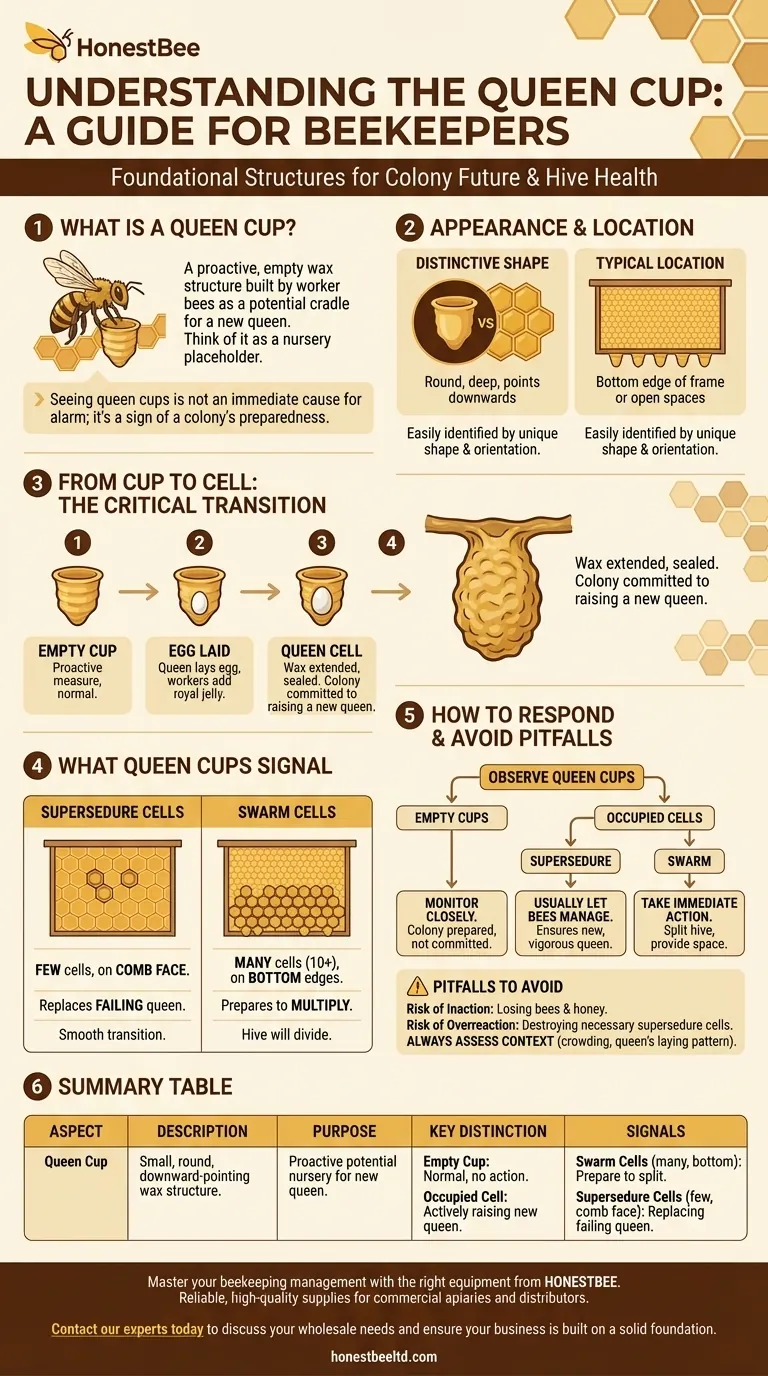
Related Products
- Brown Nicot Queen Cell Cups for Breeding Queen Bees Beekeeping
- Clear Black Plain Polystyrene Queen Bee Grafting Cell Cups No Lug for Bee Queen Cup
- JZBZ Langstroth Queen Rearing Frame for Beekeeping
- High Performance Plastic Queen Excluder for Beekeeping and Apiary Management
- Professional Queen Catcher and Introduction Queen Cage
People Also Ask
- What are the signs that a queen cell is about to emerge? Master the Critical Timing for Hive Success
- What should be done with extra queens from grafting? A Strategic Guide for Apiary Management
- How are the queen cells raised after removing the plugs? Master the Art of Queen Rearing
- Why is it important to select a healthy larva less than 24 hours old for queen rearing? Maximize Queen Quality and Colony Strength
- What role does the natural swarming process play in queen rearing? Harness the Swarm Instinct for Better Queens




